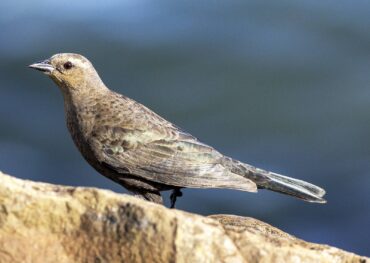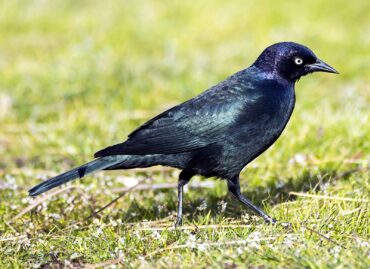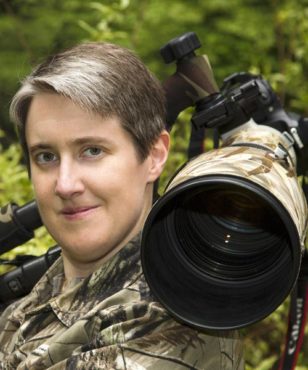
Like people, birds are sometimes unappreciated and misunderstood. While every species has its place in the ecosystem, some are bigger stars than others. Beach lovers would gladly trade a flock of “seagulls” for hummingbirds. Yet gulls, not hummingbirds, scavenge smelly carcasses from the beach.
Some dislike barn swallows for leaving messy droppings under their nests. But without swallows, we would have far more mosquitoes to contend with.
Crows are despised for having an appetite for garbage. But majestic bald eagles dine alongside corvids at dumps. Glamorous species often get a free pass, while less desirable birds can’t catch a break.
Members of the Icteridae family, or “New World blackbirds,” are a mixed bag. They include beloved beauties such as orioles, meadowlarks and bobolinks. Less popular species are the grackles and cowbirds. The ones simply called “blackbirds” are generally accepted.
North America is home to five species of “blackbirds” including red-winged, yellow-headed, rusty, tri-colored and Brewer’s blackbirds, all of which either live in Washington or occasionally visit. In West Sound, the resident blackbirds are the widely known red-winged blackbird and the lesser known Brewer’s blackbird.

Red-winged blackbirds are noisy inhabitants of marshes in spring and summer and rove around a variety of habitats in winter. The red wing patches on males are unmistakable. In contrast, their cousin, the Brewer’s blackbird, is quieter and its plumage is more subtle.
Brewer’s blackbirds sometimes associate with red-winged blackbirds, but more frequently forage in fields alongside brown-headed cowbirds and European starlings, which are not fan favorites of birders.
Despite being overlooked and unappreciated by many, Brewer’s blackbirds merit a second look. On cloudy days, they appear dull and unassuming. Males are black and females are brown. Direct sunlight reveals their true beauty.
When the sun is shining, the Brewer’s blackbird makes a splendid appearance. The male exhibits glossy, iridescent tones of dark blue, purple and metallic green, which blend together. The female’s colors are duller, but also shine in the sun. The male has piercing yellow eyes, while the female’s eyes are dark.
The Brewer’s blackbird is named for Thomas M. Brewer, a 19th-century ornithologist from Boston.
With long legs for its size, the Brewer’s blackbird walks with a chicken-like gait and jerky head motions. When coming in for a landing, it circles before beginning its slow, fluttery descent.
A medium-distance migrant in the Midwest, the Brewer’s blackbird breeds as far north as southern Canada and winters in the southern United States and Mexico. The eastern portion of its range overlaps with the range of the similar common grackle. In such areas, the Brewer’s blackbird inhabits grasslands and fields, leaving neighborhood and suburban habitat to its cousin.
Agriculture has expanded its range and preferred habitat. Populations west of the Rockies are mostly nonmigratory. In West Sound, the Brewer’s blackbird is most often seen from spring to fall at the north end of the Kitsap Peninsula, where it prefers open areas and pastures, although individuals and small flocks can show up almost anywhere.
The Brewer’s blackbird forages on the ground for grain seeds, insects and berries. Despite adjusting well to human-altered landscapes, it is considered a common species in steep decline. This is largely due to misguided perceived threats to agriculture that have resulted in unnecessary poisoning, trapping and shooting of harmless birds.
Brewer’s blackbirds may consume grain seed on farms, but they also devour numerous nuisance insects in summer, making them more of a friend to agriculture than an enemy. In fact, they readily take to new food sources and are known to help curb outbreaks of agricultural pests such as cutworms, termites and tent caterpillars.
Brewer’s blackbirds are highly social birds. In the nonbreeding season, they often join with other blackbird species, cowbirds and starlings, forming flocks with hundreds of individuals. Males act as sentinels, sending out alarm calls and attacking predators such as raptors that threaten the flock.
Females arrive on breeding grounds first and choose their nest sites. In a process that takes up to 10 days, females build their cup nests with twigs and grass, using mud or manure for cement. Monogamous pairs nest in colonies of anywhere from a few to 100 pairs. Nests may be placed in low shrubs or even high treetops.
Eggs come in a variety of colors, some plain and others with speckles, possibly to help to camouflage them. Pairs usually raise two broods of four to six eggs per year. Pairs separate at the end of the breeding season but may reconnect the following year.
Some birds have a wow factor. Others quietly contribute to the ecosystem. The Brewer’s blackbird bridges both worlds. An interesting bird that gets little attention, it is a beneficial species. Erroneously considered a black sheep, this blackbird is a beauty that shines in the sun.

























